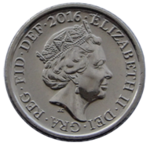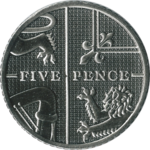Five pence (British coin)
United Kingdom | |
| Value | £0.05 |
|---|---|
| Mass | (1968–1990) 5.65 g (1990–present) 3.25 g |
| Diameter | (1968–1990) 23.59 mm (1990–present) 18.00 mm |
| Thickness | (Cupro-nickel) 1.7 mm (Steel) 1.89 mm |
| Edge | Milled |
| Composition | Cupronickel (1968–2010) Nickel-plated steel (2011–) |
| Years of minting | 1968–present |
| Obverse | |
 | |
| Design | Queen Elizabeth II |
| Designer | Jody Clark |
| Design date | 2015 |
| Reverse | |
 | |
| Design | Segment of the Royal Shield |
| Designer | Matthew Dent |
| Design date | 2008 |
The British decimal five pence coin (often shortened to 5p in writing and speech) is a denomination of sterling coinage worth 5⁄100 of a pound. Its obverse has featured the profile of Queen Elizabeth II since the coin’s introduction on 23 April 1968, replacing the shilling in preparation for decimalisation in 1971.[1] It remained the same size as the one shilling coin, which also remained legal tender, until a smaller version was introduced in June 1990 with the older coins being withdrawn on 31 December 1990.[2] Four different portraits of the Queen have been used, with the latest design by Jody Clark being introduced in 2015. The second and current reverse, featuring a segment of the Royal Shield, was introduced in 2008.
5p coins are legal tender up to the sum of £5 when offered in repayment of a debt; however, the coin's legal tender status is not normally relevant for everyday transactions.[3]
The five pence coin was originally minted from cupro-nickel (75% Cu, 25% Ni), but since 2011[4] it has been minted in nickel-plated steel due to the increasing price of metal. From January 2013, the Royal Mint began a programme to gradually remove the previous cupro-nickel coins from circulation with replacement by the nickel-plated steel versions.[5]
In March 2014, an estimated 3,847 million 5p coins were in circulation with an estimated face value of £192.370 million.[6]
Design
[edit]
The original reverse of the coin, designed by Christopher Ironside, and used from 1968 to 2008, is a crowned thistle (formally, The Badge of Scotland, a thistle royally crowned), with the numeral "5" below the thistle, and either NEW PENCE (1968–1981) or FIVE PENCE (1982–2008) above the thistle.
To date, three different obverses have been used. In all cases, the inscription is ELIZABETH II D.G.REG.F.D. 2013,[7] where 2013 is replaced by the year of minting. In the original design, both sides of the coin are encircled by dots, a common feature on coins, known as beading.
As with all new decimal currency, until 1984 the portrait of Queen Elizabeth II by Arnold Machin appeared on the obverse,[8] in which the Queen wears the 'Girls of Great Britain and Ireland' Tiara.
Between 1985 and 1997, the portrait by Raphael Maklouf was used,[8] in which the Queen wears the George IV State Diadem.
On 27 June 1990 a reduced-size version of the five pence coin was introduced. The older larger coins were withdrawn on 31 December 1990. The design remained unchanged.
From 1998 to 2015, the portrait by Ian Rank-Broadley was used,[8] again featuring the tiara, with a signature-mark IRB below the portrait.
In June 2015, coins bearing the portrait by Jody Clark were introduced into circulation.
In August 2005 the Royal Mint launched a competition to find new reverse designs for all circulating coins apart from the £2 coin.[9] The winner, announced in April 2008, was Matthew Dent, whose designs were gradually introduced into the circulating British coinage from mid-2008.[10] The designs for the 1p, 2p, 5p, 10p, 20p and 50p coins depict sections of the Royal Shield that form the whole shield when placed together. The shield in its entirety was featured on the now-obsolete round £1 coin. The 5p coin depicts the centre of the Royal shield, showing the meeting point of the four quarters. The coin's obverse remains largely unchanged, but the beading (the ring of dots around the coin's circumference), which no longer features on the coin's reverse, has also been removed from the obverse.
In October 2023 the King Charles III five-pence coin, featuring an oak leaf with acorns, was presented.[11]
Mintages
[edit]| Year | Number minted | Composition | Diameter (mm) | Portrait | Reverse |
|---|---|---|---|---|---|
| 1968 | 98,868,250 | Cupro-nickel | 23.59 | Machin | Ironside |
| 1969 | 120,270,000 | ||||
| 1970 | 225,948,525 | ||||
| 1971 | 81,783,475 | ||||
| 1972 | 0 | ||||
| 1973 | 0 | ||||
| 1974 | 0 | ||||
| 1975 | 141,539,000 | ||||
| 1976 | 0 | ||||
| 1977 | 24,308,000 | ||||
| 1978 | 61,094,000 | ||||
| 1979 | 155,456,000 | ||||
| 1980 | 220,566,000 | ||||
| 1981 | 0 | ||||
| 1982 | 0 | ||||
| 1983 | 0 | ||||
| 1984 | 0 | ||||
| 1985 | 0 | Maklouf | |||
| 1986 | 0 | ||||
| 1987 | 48,220,000 | ||||
| 1988 | 120,744,610 | ||||
| 1989 | 101,406,000 | ||||
| 1990 | 1,634,976,005 | 18.00 | |||
| 1991 | 724,979,000 | ||||
| 1992 | 453,173,500 | ||||
| 1993 | 0 | ||||
| 1994 | 93,602,000 | ||||
| 1995 | 183,384,000 | ||||
| 1996 | 302,902,000 | ||||
| 1997 | 236,596,000 | ||||
| 1998 | 217,376,000 | Rank-Broadley | |||
| 1999 | 195,490,000 | ||||
| 2000 | 388,512,000 | ||||
| 2001 | 337,930,000 | ||||
| 2002 | 219,258,000 | ||||
| 2003 | 333,230,000 | ||||
| 2004 | 271,810,000 | ||||
| 2005 | 236,212,000 | ||||
| 2006 | 317,697,000 | ||||
| 2007 | 246,720,000 | ||||
| 2008 | 92,880,000 | ||||
| 165,172,000 | Dent | ||||
| 2009 | 132,960,300 | ||||
| 2010 | 396,245,500 | ||||
| 2011 | 50,400,000 | Nickel-plated steel | |||
| 2012 | 339,802,350 | ||||
| 2013 | 378,800,750 | ||||
| 2014 | 885,004,520 | ||||
| 2015 | 163,000,000 | ||||
| 536,600,000 | Clark | ||||
| 2016 | 305,740,000 | ||||
| 2017 | 220,515,000 | ||||
| 2018 | 0 | ||||
| 2019 | 92,800,000 | ||||
| 2020 | 49,200,000 | ||||
| 2021 | 28,000,000 | ||||
| 2022 | 42,800,000 | ||||
| 2023 | 32,400,000 | Jennings | The Royal Mint |
Mint sets have been produced since 1982; where mintages on or after that date indicate 'none', there are examples contained within those sets.
References
[edit]- ^ Bignell, C P. "Post decimalisation". Archived from the original on 23 June 2012. Retrieved 23 May 2006.
- ^ Stephen Eckett; Craig Pearce (2008). Harriman's Money Miscellany: A Collection of Financial Facts and Corporate Curiosities. Harriman House Limited. p. 19. ISBN 978-1-905641-95-6.
- ^ Royal Mint Frequently Asked Questions Archived 8 January 2009 at the Wayback Machine
- ^ Decimal Five Pence Archived 26 September 2017 at the Wayback Machine | author=Tony Clayton
- ^ "Cupro Nickel Replacement Programme". Royal Mint. 2013. Archived from the original on 30 March 2013. Retrieved 24 February 2013.
- ^ "Mintage Figures". Royal Mint. Archived from the original on 17 May 2013. Retrieved 28 December 2015.
- ^ Clayton, Tony. "Decimal Coins of the UK – Bronze". Archived from the original on 27 May 2007. Retrieved 24 May 2006.
- ^ a b c "1p Coin". British Royal Mint. Archived from the original on 27 April 2006. Retrieved 23 May 2006.
- ^ "Royal Mint seeks new coin designs" Archived 13 May 2014 at the Wayback Machine, BBC News, 17 August 2005
- ^ "Royal Mint unveils new UK coins" Archived 7 September 2008 at the Wayback Machine, 2 April 2008
- ^ BBC
- ^ "5p Five Pence Mintage Figures". www.royalmint.com. Retrieved 2 September 2023.
